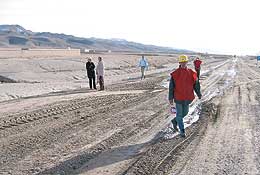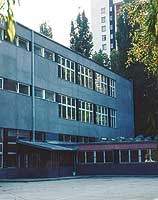In looking for the secret to successfully rebuilding Iraq, the Bush Administration may review previous reconstructions in other war-torn lands such as Kuwait, Bosnia-Herzegovina and even now in Afghanistan. While much has been accomplished in places where the U.S. and its allies have waged war in the last dozen years, reconstruction experts say, nothing helps restore infrastructure like a stable government, security and new sources of national wealth.
In 1991, as Saddam Hussein's soldiers were being routed from Kuwait by a U.S.-led coalition, they laid waste to oil fields, infrastructure and buildings. A key step came when the Kuwaitis sought prices from private contractors to lead the rebuilding.
 |
|
LONG ROAD Key highway in Afghanistan is being rebuilt, but some want more big projects. (Photo courtesy of Berger Group) |
After some sticker shock, they persuaded the first Bush Administration to allow them to use the U.S. Army Corps of Engineers. It was hired to repair civil infrastructure and buildings while Bechtel Corp. led oil-related reconstruction. By paying Corps salaries plus about 10% for overhead and additional equipment, the Kuwaitis saved hundreds of millions, says Ralph Locurcio, a former Corps general who headed the work in Kuwait and now is senior vice president of STV Inc., New York City. "Our total bill was about $600 million for 300 days of reconstruction," recalls Locurcio, including hard costs, salaries and overhead.
A different scenario applied in Bosnia-Herzegovina, where a three-year war that devastated infrastructure ended with a 1995 peace agreement. Some 2,000 km of highways and 70 bridges were destroyed, says the World Bank. Power generation had fallen by more than a half. The U.S. Agency for International Development (USAID) funded at least $265 million worth of work on 845 power, water, road and other projects.
Parsons Corp., Pasadena, Calif., hired by USAID as program manager there, had to bid openly for the work, unlike the current Iraq contract, says Djurica Tankosich, a vice president in London. "At that time, USAID didnt have a lot of [that kind of] experience and they went for whichever procurement rules they had at the time."
John Stewart, Parsons project director in Bosnia from 1998 to 2000, says work began even as areas were still being bombed. But a bigger obstacle was finding subcontractors. "There had been 50 years of state-run government," he says. "The locals didnt know how to bid. I had mayors come in and want contracts for their brothers-in-law."
Stewart says quality and schedule got a big boost when subs and workers saw they would be paid on time in cash, rather than in "diesel fuel and cabbages," he says. "We put a lot of people back to work, we boosted the economy and showed local firms how to compete in a world market."
Reconstruction of Broad Bridge, a key span between Bosnia and Croatia, was done on time in 15 months and on budget, despite replacement of all precast girders, each 33 meters long, says Stewart. "We also rebuilt 14,000 km of low voltage concrete poles," he says. Stewart also credits the relationship with USAID. "We had differences, but it was not just client and contractor," he says.
While the regional power system is still unreliable, Parsons USAID contract ends at the end of the year. The firm hopes for new work through its long-time local partner. But the rewards are not all financial. "Young children sang thank you to us when we left," says Stewart.
A much more modest but still daunting reconstruction began in Afghanistan last year after the U.S. largely ousted the Taliban. Little of what infrastructure had been built still remained after decades of civil war and deterioration. Today, Afghanistans fledgling government depends on aid from relief organizations, the U.S. and other countries. Skirmishes between troops and Taliban remnants and other hostile groups continue.
Because the new government and other Afghan organizations are considered incapable of running reconstruction, it is led by international relief and development agencies. USAID says it has supported over 225 spot reconstruction jobs at government buildings, schools, roads and bridges. It has reopened the heavily used Salang Tunnel and is rebuilding 31 bridges.
USAID also awarded Louis Berger Group Inc., East Orange, N.J., a wide-ranging contract to oversee infrastructure redevelopment, including rebuilding the 600-mile highway from Kabul to Kandahar to Herat. Asphalt soon will be applied to 52 miles that have been de-mined, graded, and leveled, USAID reports. Berger, in turn, is awarding subcontracts to six joint-ventures comprised of Afghan companies working as partners with firms from other nations.
Berger Chairman Derish Wolff says the tasks of emergency relief, reconstruction and nation-building have become inseparable in recent years. Relief organizations are more involved in construction, and builders such as the Corps of Engineers are being drawn into relief and economic development, he says.
Under the new order, Americans can no longer send in "John Wayne and the Seabees" and expect that nation-building will result, says Wolff. "Who would have dreamed that the thing needed in Iraq was police? The world is changing."
 |
 |
| WAR DAMAGE School in Bosnia (left) gets a USAID-funded facelift. (Photo courtesy of Parsons Corp.) |
Not fast enough, says M. Saleh Keshawarz, an Afghan native and chairman of the civil and environmental engineering department at the University of Hartford, Hartford, Conn. He has returned to his homeland to visit since the Taliban fell, but his optimism has given way to despair. Afghanistan suffers from too many freelance consultants and non-governmental organizations, he says. Many want opportunity but have little knowledge of the country. "There is no visible reconstruction going on except for people rebuilding their houses and some small-scale jobs," he says.
Keshawarz points to squandered opportunity to improve Afghanistans water systems following a years-long drought that required international aid to prevent starvation. USAID says it has completed 6,100 water-related projects, but he sees what remains undone. "Despite an abundance of water around the country this year, there is no sign of reconstruction activity in the irrigation system or transportation that could make a difference in people's lives," he says.

Post a comment to this article
Report Abusive Comment